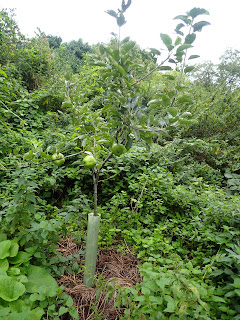Local Orchards: Pevensey Road, Berrylands LNR, & Park Road Allotments Isleworth
The above displays none of the characteristics of the two apples I graft:- Kingston's own heritage variety Mitchelson's Seedling Kingston's apple story ; and the russety, Claygate Pearmain. The first port of call when attempting apple ID is the New Book of Apples by Morgan and Richards. The second is Fruit ID which contains a lot of not - in - books info, accounting for information obtained from DNA. This includes synonymous varieties (sharing the genetic make - up) such as Chelmsford Wonder. Makes you wonder how an apple thrown into a hedge - classified as a seedling - turned out to be the same as grafted stock.
Mitchelson's Seedling Berrylands Nature Reserve August 2023
But wait, I recognise this green gargantuan apple as one purchased >20 years ago from Homebase; very like a Bramley, sufficiently sweet to eat and huge. In fact, a trip round the orchards we planted 2018 - 21 indicates that of the 10 scions taken, a tree also ended up at the Berrylands Nature Reserve orchard.
There are about 40 apple trees hidden in the vegetation at Pevensey Road Local Nature Reserve, as well as a new orchard planted at the adjoining Leitrim Park. Some trees appear quite old, although the area was scorched http://bombsight.org/ WW2, so perhaps ~ 6o years old. However, as some are multi - stemmed, it is possible that they are re-growths. This means they have considerable value for wildlife.
Surveys by PTES have indicated that 90% of traditional orchards have been lost since the 1950s to neglect, development or conversion to intensive modern orchards which contribute a negative impact on biodiversity. Furthermore, 45% of the remaining orchards surveyed in England and 35% of orchards in Wales were found to be in declining condition as a habitat. By far the most common reason for this is lack of replacement tree replanting, meaning these remaining old orchards will quickly disappear. see here for the importance of biodiversity Orchard Biodiversity
Migratory male Gypsy moth on an apple at Pevensey Road
Like so many once-common species, it is the destruction of formerly numerous old orchards, the habitat its larva need to thrive, that have led to its decline.
It is on the UK’s list of species vulnerable to extinction, and that is one of the reasons that People’s Trust for Endangered Species is trying to stop the destruction of orchards with apple and cherry that are 50 to 80 years old. It also hopes people will report previously unrecorded orchards (and beetles).Qualitative habitat information is available from MAGIC and it is an excellent resource, for example the screenshot below attests that PR is broad leaved woodland (priority habitat) adjacent to areas of BL woodland and Open Mosaic Habitat (priority habitat) at the old Marshaling yards, but it doesn't give any information about the orchard.
Traditional orchards are priority habitat in the UK. The Orchard Project
has registered PR as an community orchard, but it has not been
registered on the Defra website magic.defra and perhaps should be on account of the age of the trees. Both are available to view at the PTES website Traditional Orchards & Community Orchard Read about our community and traditional orchards in Kingston Green Lane & St John's the Baptist
Six miles north, at Park Road Isleworth, there is an orchard contained within 3 acres of allotments which groups https://isleworthsociety.org/ are fighting to save at a Public Inquiry APP/F5540/W/22/3297232. The landowner, the Duke of Northumberland, has made an application for the erection of 80 residential dwellings, concierge building, car and cycle parking, landscaping and associated works.
As well as being an asset of community value, with important wildlife features including pond; a tree survey undertaken (2018) indicated 27 apples, 11 cherries, 8 plums, 8 damsons, 3 pears, 3 greengage and cobnut, some trees (see below) exhibit the veteranised features only developed through age.
“… Brentford, Isleworth and Twickenham are almost a garden and orchard of apple trees, pears, plums, cherries etc. Isleworth is also celebrated for strawberries”.
But even when your orchard is researched, surveyed and registered there are still hurdles to go through, Coton Orchard, Cambridgeshire (1,000 trees); part of the orchard is registered on MAGIC as traditional and therefore priority habitat.
There are Barbastelle bats (an Annex 2 species given higher protection) recorded using the orchard, the habitats either side, with a roost nearby. These bats are known to have a higher core sustenance zone requirement than many other species, yet the County Council have decided this is the route for a bonkersbusway which will see this area completely changed.










ReplyDeleteso helpful.
bodyguard services London